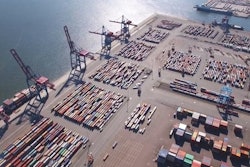
New technologies often present an attractive solution when looking for ways to optimize and improve operations across your supply chain, especially as your business grows. And, while it’s true that automation and analytics can take your business to the next level, adding capabilities before you need them can bog you down with unnecessary complexity.
However, it’s possible to match up analytics and automation to the maturity of your business, and adding the right pieces at the right time creates a virtuous cycle. Information from your analytics tells your systems what to do, which identifies the areas where automation makes the most sense. Here’s how to grow those areas along with your company.
Stage 1: Understanding what has happened
If you’re just getting started in business, you probably look at freight costs strictly as an expense. At this point, the concentration is typically focused on ensuring that business is bringing in money and that the supply chain is mostly reliable, so your focus remains on the day-to-day execution rather than on long-term strategic efficiencies and sophisticated metrics.
At this point, you can get by with basic descriptive analytics that tell you what has been happening along the supply chain. You’ll want to understand what happened in your most recent shipments and compare that to previous months. By looking at historical data by region, by month and by shipping mode, you’ll be able to get a high-level picture of how business is running and uncover potential opportunities for improvement.
Stage 2: Digging into the why
Most companies find themselves at this level, where they know what has been happening but want to understand why. With that knowledge, it becomes possible to enable a proactive approach to create opportunities and efficiencies in your supply chain.
Once you have information like revenues, on-time performance and operating margin, you can better understand all of the factors that go into shifts in cost. This allows you to optimize and clean up any issues causing prices to increase while enabling you to take advantage of factors that have helped keep costs down.
At the first stage, you’re able to say, “we spent $500,000 on shipping last year, which was up 20% from the previous year, and here are the regions where we spent that money.” But, with more diagnostics and analytics to show the reason behind that increase, it becomes clear where some carriers perform better than others, or that your spending increases in early spring, or that shipping by rail lost money — all of which leads to more informed decisions.
At this stage, gaining access to analytics and understanding your supply chain’s driving forces are top priorities. Adding automation is likely to complicate matters before you have achieved a firm grasp of them.
Stage 3: Understanding what’s going to happen in the future
At this stage, you have gained a deeper understanding of your supply chain analytics, and you are ready to add automation to take it to the next level. To make automation work, you’re going to need data — a lot of it. The good news is that shippers at this level typically have plenty of data to work with. The bad news is that it's normally spread across various systems and spreadsheets.
By bringing all this disparate information together and automating reports of warehouse data, inventory data, logistics data and more, you become better at analyzing risk and picking out where the inefficiencies in the system lie. Furthermore, by pulling together information from relevant external sources—weather reports, holiday hours, infrastructure changes—you can begin to predict certain events. With insights like these, you’ll know, for example, that a sunny spring in Florida means more trucks headed that way and the chance to take advantage of cheaper rates.
Automation is a major step toward looking forward as a business. You’ll be able to understand what’s going to happen, which will lead to significantly more savings, a scaled-up operation and increased productivity.
Stage 4: The future is here. What should you do about it?
Up to this point, you’ve used analytics to understand what’s going on and found where automation makes sense. The goal is to optimize all phases of the operation, leaving you and your team to make quick, responsive decisions on anything that falls out of the normal set of rules.
Combining everything from the previous three tiers will help you reach maximum efficiency and take things even further. Being able to describe what happened in the past and trace the reasons for it will allow you to understand, predict and proactively make a recommendation.
Something as essential to supply chain managers as the routing guide can be transformed with recommendations. Now, instead of a traditional, rules-based document for vendors and suppliers, a dynamic routing guide can respond to unfolding market conditions and adapt in real-time, recommending updates to those rules along the way. When the market returns to normal, the routing guide does as well.
Conclusion
There is one common thread that runs through all these tiers: data. At every level, it’s critical to keep data in a central location. As the business grows, you’re in for a major headache if your data is in disparate systems and silos.
Wherever you are in the life of your business, there’s a level of automation and/or analytics to fit specific requirements. In the early stages, ad hoc reports and dashboards provide valuable information. As the company grows, you can automate how that data is collected and sent to a central location. Eventually, you’ll be managing fully automated processes and flows. Matching up these capabilities with the maturity level of your business can significantly improve and streamline your operations.



















